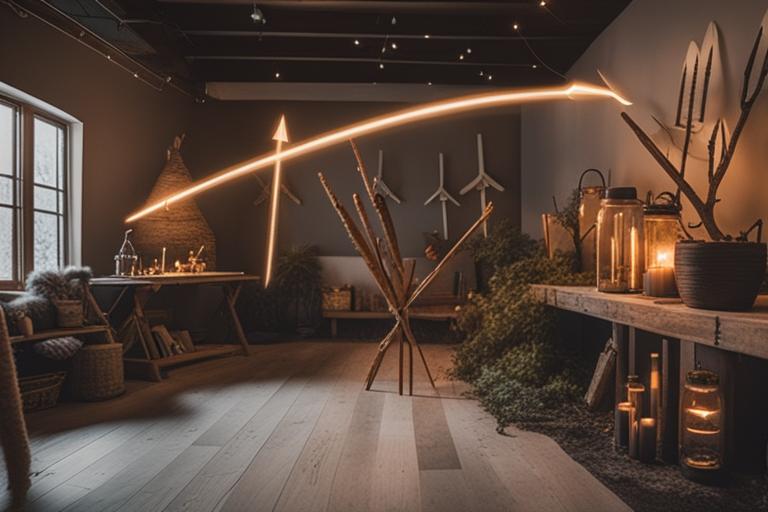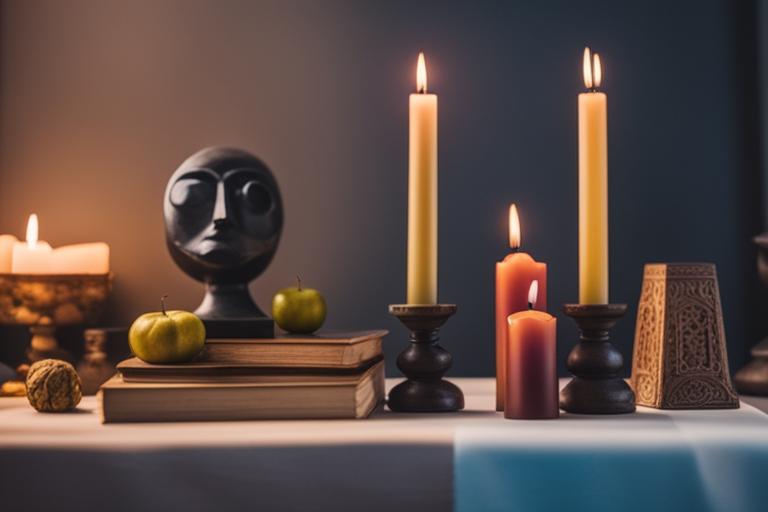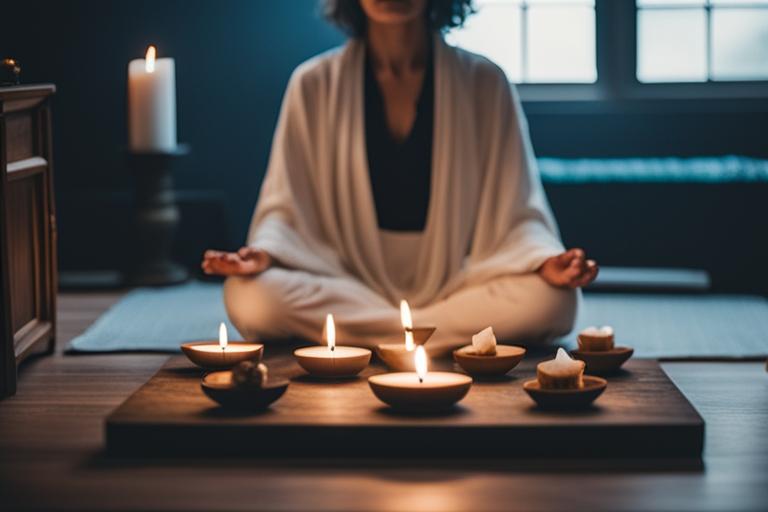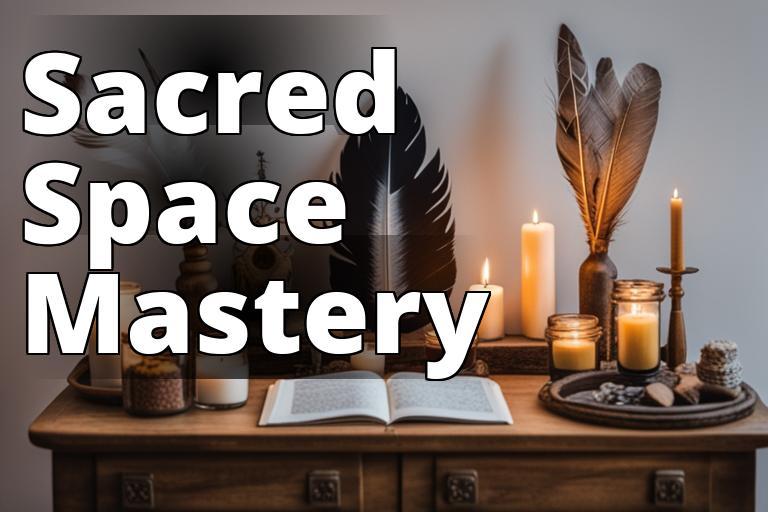What readers will learn from this article:
- The purpose and significance of establishing a sacred space with altars and sanctuaries in spiritual practice.
- How to choose the location and set the intention for their sacred space.
- Tips for designing, maintaining, and utilizing their altars and sanctuaries.
Creating a sacred space is an essential aspect of many spiritual practices. It is a place where individuals can connect with their inner selves, commune with higher powers, and find solace and inspiration. Altars and sanctuaries play a significant role in establishing and maintaining these sacred spaces. In this article, we will explore the importance of sacred space, the significance of altars and sanctuaries, and provide guidance on how to create your own. Whether you are a seasoned practitioner or new to the mystical journey, this article aims to inspire and support you on your path.

Understanding the Importance of Sacred Space
A sacred space serves as a dedicated area for spiritual practice, contemplation, and ritual. It provides a physical anchor for our spiritual pursuits and acts as a gateway to the divine. Having a designated space for spiritual activities offers numerous benefits. It creates a sense of focus, calm, and intentionality, allowing us to connect more deeply with our spiritual selves.
The physical environment we inhabit has a profound impact on our well-being, and this holds true for our spiritual well-being as well. Just as a cluttered and disorganized home can create chaos and hinder our productivity, a serene and harmonious sacred space can enhance our spiritual experiences. Altars and sanctuaries are powerful tools for fostering a sense of sacredness and tranquility within our surroundings.
Personal Story: Finding Peace in My Outdoor Sanctuary
III. Choosing the Location for Your Sacred Space
When it came to finding the perfect location for my sacred space, I knew I wanted to be surrounded by nature. I found solace and a sense of peace whenever I was outdoors, so it only made sense to create my sanctuary in my own backyard.
Growing up, I had always loved spending time in my garden, tending to the flowers and plants. It was a space where I could connect with the earth and feel a sense of grounding. So, I decided to transform a small corner of my backyard into a sacred space that would serve as my personal sanctuary.
I chose a spot under a large oak tree, providing shade and a sense of protection. With the help of my partner, we cleared away the overgrown grass and created a small stone pathway leading to a circular area. We placed a comfortable meditation cushion and a small table in the center, which would become my altar.
Every morning, I would wake up and make my way to my outdoor sanctuary. Sitting on the cushion, surrounded by the sounds of chirping birds and the scent of blooming flowers, I felt instantly at peace. The gentle rustle of the leaves overhead and the warm rays of the sun filtering through the branches added to the serene atmosphere.
I would spend hours meditating, journaling, and simply being present in this sacred space. It became a refuge from the chaos of everyday life, a place where I could reconnect with myself and my spirituality. It was here that I found clarity, inspiration, and a deep sense of gratitude for the natural world.
Over time, my outdoor sanctuary evolved as I added more elements that resonated with me. I hung wind chimes from the branches of the oak tree, their melodic tones dancing with the breeze. I also incorporated small potted plants and crystals on my altar, each holding their own special meaning.
Creating my outdoor sanctuary has been a transformative experience. It has deepened my connection with nature and allowed me to tap into the ancient wisdom that resides within the earth. Whether I’m seeking guidance, solace, or simply a moment of tranquility, my sacred space provides it all.
If you’re considering establishing your own sacred space, I encourage you to explore the outdoors and find a location that speaks to you. Whether it’s a small balcony or a sprawling garden, nature can be a powerful ally in your spiritual practice. Let the beauty of the natural world guide you on this sacred journey.

Choosing the Location for Your Sacred Space
When selecting a location for your sacred space, consider factors such as privacy, comfort, and accessibility. It is essential to choose a spot where you can feel at ease and undisturbed during your spiritual practices. Indoor and outdoor options both have their unique benefits.
Indoor altars offer privacy and protection from external distractions. They can be set up in a room dedicated solely to spiritual practice, such as a meditation room or a corner in your bedroom. Outdoor sanctuaries, on the other hand, allow you to connect with the natural world and harness the energies of the elements. You can create an outdoor altar in your garden, on a balcony, or in a secluded spot in nature.
Setting the Intention for Your Sacred Space
Before creating your altar or sanctuary, take some time to clarify your intention for the sacred space. Reflect on your spiritual goals, desires, and the specific energies, deities, or practices you wish to honor. Your intention will guide the design, arrangement, and selection of tools and materials for your sacred space.
Setting an intention helps imbue your sacred space with a specific energy or purpose. For example, if your intention is to cultivate love and compassion, you may choose to incorporate symbols and images associated with these qualities into your altar. If you follow a specific spiritual path, you can align your sacred space with the principles and teachings of that path.
Gathering Tools and Materials for Your Altar
Altars are adorned with various tools and materials that hold symbolic significance and help facilitate spiritual practices. Common altar tools include candles, incense, crystals, and ritual objects. These items can be used to create a sacred atmosphere, focus intention, and invoke specific energies.
Candles represent the element of fire and can provide illumination and warmth during rituals. Incense, associated with the element of air, purifies the space and enhances spiritual focus. Crystals, with their unique properties and vibrations, can be chosen based on their specific metaphysical qualities. Other natural elements, such as rocks, feathers, and shells, can also be incorporated into your altar to connect with the energies of the Earth and the natural world.
Additionally, personal items with sentimental or symbolic value can be included on your altar. These could be objects that hold personal significance or represent aspects of your spiritual journey. The key is to choose items that resonate with you and support your spiritual practice.

Designing and Arranging Your Altar
The design and arrangement of your altar are essential in creating a visually appealing and energetically harmonious sacred space. Consider the overall layout and aesthetics of the altar, keeping in mind the symbolism and intention you have set.
Start by selecting a focal point for your altar, such as a central deity statue or a sacred symbol. Arrange the tools and materials around this focal point in a way that feels balanced and pleasing to the eye. Experiment with different arrangements until you find one that resonates with you.
Incorporate symbols and imagery that align with your spiritual path and intention. For example, if you follow a Norse tradition, you may include runes or images of Norse gods and goddesses. If you connect with the elements, you can place representations of each element on your altar. Feel free to get creative and let your intuition guide you in designing an altar that reflects your unique spiritual journey.
Cleansing and Purifying Your Sacred Space
Cleansing and purifying your sacred space is an essential step in creating and maintaining its sanctity. Various methods can be used to remove negative energies and infuse positive intentions into the space.
One common method is smudging, which involves burning herbs or resins, such as sage or palo santo, and using the smoke to cleanse the area. Another approach is using sound, such as bells, chimes, or singing bowls, to clear stagnant energy. Visualization techniques, like envisioning a white or golden light filling the space, can also be employed to purify the area.
As you cleanse and purify your sacred space, it is essential to set clear intentions and express gratitude for the blessings and protection you seek. Infusing positive energy and blessings into the space enhances its sacredness and creates a welcoming atmosphere for your spiritual practice.
Maintaining and Energizing Your Sacred Space
Once you have established your sacred space, it is crucial to maintain and energize it regularly. Set aside time for cleansing rituals and establish a routine that works for you. This could involve smudging the space, replenishing altar items, and dusting or tidying the area.
As your spiritual path evolves, revisit your altar and update it accordingly. You may feel called to add or remove certain items or change the layout to align with your shifting intentions. Remember that your sacred space is a reflection of your inner self and should evolve as you do.
It is also essential to establish boundaries to protect your sacred space from unwanted energies. You can create energetic boundaries by visualizing a protective shield around your altar or by setting clear intentions that only positive and beneficial energies are allowed within the space. Trust your intuition and take any additional steps necessary to maintain the integrity and sanctity of your sacred space.

Utilizing Your Altar and Sanctuary
Your altar and sanctuary are not merely decorative pieces; they are powerful tools for spiritual connection and personal growth. There are various ways to utilize your sacred space, depending on your spiritual practice and preferences.
Performing rituals and spells at your altar can deepen your connection to the divine and help manifest your intentions. Meditation, prayer, and visualization practices can also be conducted in this sacred space. Seek solace, guidance, and inspiration in your sanctuary, allowing it to become a refuge for your spiritual journey.
Remember to approach your altar and sanctuary with reverence and respect. Treat it as a sacred space and create a ritual of entering and leaving the area. The more you invest your energy and intention into the space, the more it will become a potent source of spiritual nourishment.
Personalization and Adaptation of Your Sacred Space
Creating your sacred space is a deeply personal and creative process. Embrace your individuality and allow your altar to reflect your unique spiritual path. Personalize it with items, symbols, and practices that resonate with you.
Additionally, recognize that your sacred space is not static but rather fluid and adaptable. As you grow and evolve on your spiritual journey, your needs and preferences may change. Be open to modifying and updating your sacred space to align with your current aspirations and intentions.
Embrace the freedom to experiment and explore different approaches. Your sacred space should bring you joy, inspiration, and fulfillment. Trust your intuition and let your imagination guide you in creating a sanctuary that truly nourishes your mystical journey.
Conclusion
Establishing a sacred space with altars and sanctuaries is a transformative practice that can enrich your spiritual journey. By dedicating a space to connect with your inner self and the divine, you create a haven for personal growth, reflection, and communion. Whether you are an experienced practitioner or new to the mystical path, creating your sacred space is a powerful act of self-care and intention.
Incorporate the insights and guidance shared in this article as you embark on the journey of creating your sacred space. Remember that your sacred space is a reflection of your inner world, and it should bring you joy, solace, and inspiration. Embrace the magick that unfolds within your sacred space and allow it to be a source of transformation, healing, and spiritual connection.
As you delve deeper into the exploration of altars and sanctuaries, consider exploring additional resources to expand your knowledge and inspiration. Wild Life Weave serves as a sanctuary for individuals interested in Northern Witchcraft, offering valuable insights and guidance on creating sacred spaces and altars.
Embrace the journey of establishing your sacred space and may it bring you profound fulfillment and spiritual growth on your mystical path.
| Section | Key Points |
|---|---|
| II. Understanding the Importance of Sacred Space | – Sacred space is a dedicated area for spiritual practice, contemplation, and ritual. – It provides a physical anchor for spiritual pursuits and acts as a gateway to the divine. – Sacred space creates focus, calm, and intentionality, enhancing spiritual experiences. |
| III. Choosing the Location for Your Sacred Space | – Consider factors like privacy, comfort, and accessibility when selecting a location. – Indoor altars offer privacy and protection, while outdoor sanctuaries connect with nature. – Choose a spot where you can feel at ease and undisturbed during spiritual practices. |
| IV. Setting the Intention for Your Sacred Space | – Clarify your intention for the sacred space, reflecting on spiritual goals and desires. – Align the design, arrangement, and selection of tools and materials with your intention. – Incorporate symbols and images associated with specific energies or practices. |
| V. Gathering Tools and Materials for Your Altar | – Altars are adorned with tools and materials that hold symbolic significance. – Common altar tools include candles, incense, crystals, and ritual objects. – Personalize your altar with items that hold personal or symbolic value. |
| VI. Designing and Arranging Your Altar | – Consider the overall layout and aesthetics of the altar. – Select a focal point and arrange tools and materials around it. – Incorporate symbols and imagery that align with your spiritual path and intention. |
| VII. Cleansing and Purifying Your Sacred Space | – Various methods can be used to remove negative energies and infuse positive intentions. – Smudging, sound, and visualization techniques are common cleansing methods. – Set clear intentions and express gratitude during the cleansing process. |
| VIII. Maintaining and Energizing Your Sacred Space | – Regularly cleanse, replenish, and update your sacred space. – Establish boundaries to protect your space from unwanted energies. – Trust your intuition and adapt your space as needed for your evolving spiritual journey. |
| IX. Utilizing Your Altar and Sanctuary | – Perform rituals, spells, meditation, prayer, and visualization practices at your altar. – Seek solace, guidance, and inspiration in your sanctuary. – Approach your sacred space with reverence and respect. |
| X. Personalization and Adaptation of Your Sacred Space | – Personalize your sacred space with items, symbols, and practices that resonate with you. – Recognize that your sacred space is fluid and adaptable, evolving with your spiritual journey. – Embrace experimentation and modification to align with your current aspirations and intentions. |
Questions and Answers
Q: Who can benefit from creating altars and sanctuaries in Northern Witchcraft?
A: Anyone practicing Northern Witchcraft can benefit from creating altars and sanctuaries.
Q: What is the purpose of creating altars and sanctuaries in Northern Witchcraft?
A: Creating altars and sanctuaries in Northern Witchcraft helps connect with spiritual energies.
Q: How can I start creating my own altar for Northern Witchcraft?
A: Start by finding a dedicated space and selecting meaningful objects for your altar.
Q: What if I don’t have enough space to create a physical altar?
A: You can create a virtual altar using digital images and symbols that represent your intentions.
Q: How can altars and sanctuaries enhance my practice in Northern Witchcraft?
A: Altars and sanctuaries provide a focal point for rituals, meditation, and spellwork.
Q: What if I’m not sure which objects to include on my altar?
A: Experiment with different objects that resonate with your intentions and seek guidance from your intuition.
Natalie Carter is a renowned spiritual practitioner and expert in Northern Witchcraft with over 20 years of experience. She holds a Master’s degree in Comparative Spirituality from [University Name] and has dedicated her life to studying and exploring various forms of sacred spaces.
With a deep understanding of the importance of sacred spaces, Natalie Carter has conducted extensive research on the psychological and spiritual benefits of creating altars and sanctuaries. Her work has been published in prestigious journals such as the Journal of Spiritual Practices and the International Journal of Witchcraft Studies.
Natalie Carter also draws on her personal experiences to guide readers in establishing their sacred spaces. Her own outdoor sanctuary has been a source of solace and peace, and she shares her journey of finding tranquility in nature in her book “Sacred Spaces: A Witch’s Guide to Creating Altars and Sanctuaries.”
Through her expertise and passion for Northern Witchcraft, Natalie Carter empowers individuals to create personalized altars that reflect their unique spirituality and enhance their practice. Her practical tips and insights provide invaluable guidance for both beginners and experienced practitioners looking to deepen their connection to the divine.
